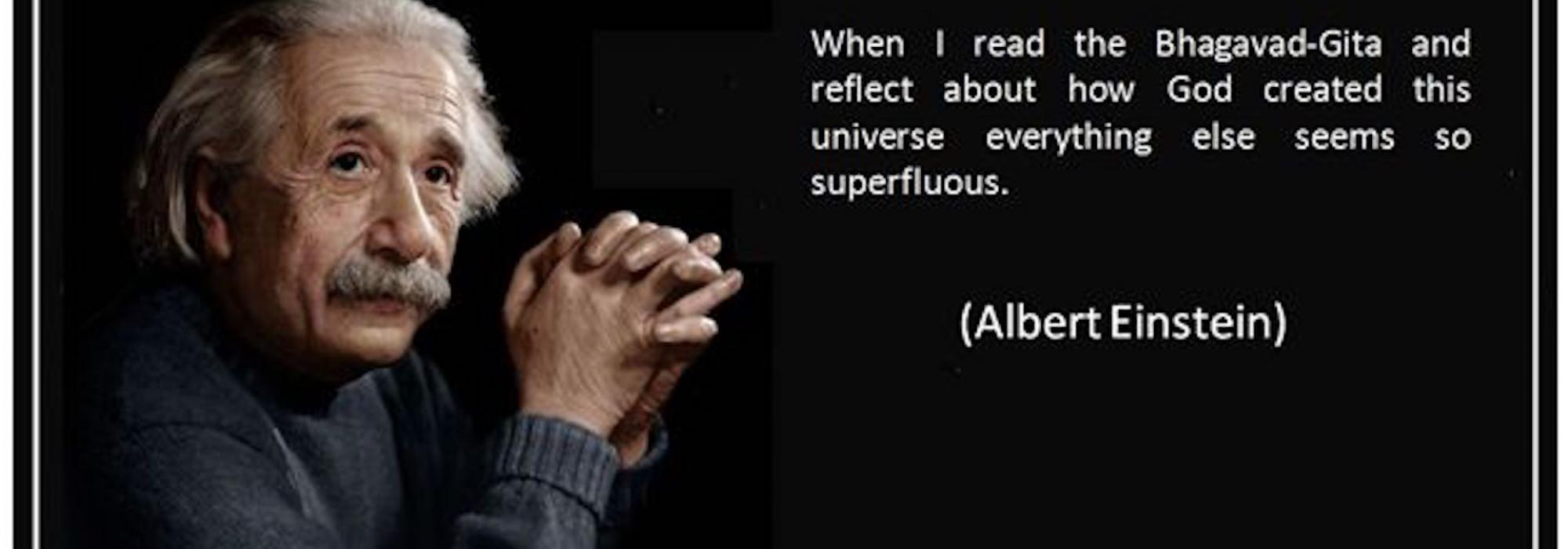Once when Rabindranath Tagore visited a large library in America, he expressed a desire to see the most prized books which were kept there. The officials there brought before him several books that were carefully wrapped in a cloth and delicately preserved. Among them, Tagore’s attention was drawn to a rare edition of the Bhagavad Gita.
When we recall that owing to special circumstances or perhaps due to various other reasons, numerous Western thinkers and poets were drawn into the dense influence of the Gita, we obtain great clarity on the universality of the work. Thomas Carlyle, Mathew Arnold, William Wordsworth, Ralph Waldo Emerson, Henry David Thoreau, Walt Whitman, Aldous Huxley…the list is long! The fact that T.S. Eliot, the most renowned among the modern English poets was deeply influenced by Gita and the Upanishads is clearly evident from his famous poem, Four Quartets.
When Dr. B.M. Gupta, an Indian Physicist went to America in 1948-49 to pursue advanced research, he met Albert Einstein in Princeton University. When Einstein learned that this man was from India, he began to speak enthusiastically about the Bhagavad Gita and the spiritual and philosophical tradition of India. But when he realized that the poor Gupta had absolutely no knowledge of even basic Sanskrit nor was he acquainted with the Gita, Einstein became disappointed. And was astonished. He showed Gupta his personal collection of the Gita and other Sanskrit works and said: “I have read many Sanskrit works including the Gita. I have made the Gita the main source of my inspiration and guidance.”
The Seton Hall University in the University, inspired and founded by Roman Catholic missionaries has included the study of the Bhagavad Gita for all its students. Located in the New Jersey region, a good number of students studying in this university include Jews, Christians, Muslims and Buddhists. In order to meet the demands of the students there, Professor Stephen Michel has published a new translation of the Bhagavad Gita.
Tilak’s Gita Rahasya
Tilak’s Gita Rahasya or the commentary on Karma Yoga was written about 115 years ago (1910-11). Because nearly five generations have passed since then, it is essential to narrate to the youth of today the circumstances under which Tilak’s work was written. The Bhagavad Gita originated on battlefield. Just like how in the Mahabharata, the forces of Sattva declared war against the forces of Tamas, Tilak declared war against the oppressive British regime. The British Government trumped up charges of treason against Tilak and sent him off to the Mandalay prison in faraway Brahmadesha (today’s Myanmar). The indirect benefit of six long years of solitary imprisonment was the composition of a stellar work like Gita Rahasya. It is true that Tilak began a deep study of the Bhagavad Gita before his incarceration (1908). Even as the writing of Tilak’s six hundred page-long commentary on the Gita was in progress, the interest of Bharatiyas about this work was aroused.
In writing this book, Tilak has made an exhaustive study of the works of more than forty Indian and foreign scholars and has used them as references.
The dedication of Tilak’s work, in the original Marathi reads, “samarpaye graṃthamidaṃ śrīśāya janatātmane.” In a very short time after its publication (1915) Madhavrao Sapre’s Hindi translation (1917) was also published and became a cause for the work’s widespread dissemination.
Because of the originality and relevance of Tilak’s work, it became the subject of study on the part of both scholars and lay people.
Pervasive Reach
Over the last ninety years, the Gorakhpur-based Gita Press has created a world record in the publication and distribution of Dharmic literature. So far, it has published and distributed nearly 60 crore books in all Indian languages. Of these, the various editions of the Bhagavad Gita alone total up to nearly 12 crores.
The Bhagavad Gita is also available in Urdu.
On May 5 1945, the scientist Oppenheimer witnessed an experimental explosion of the atomic bomb in a desert near Mexico. He was the foremost among the inventors of the bomb. Later, when delivering lectures at various universities, during a question-answer session, he remarked that the explosion reminded him of the description of the Vishwaroopadarshana of the Bhagavad Gita. This was reported in the media.
The astronaut of our own time, Sunitha Williams said, “During my travel in outer space, the Bhagavad Gita that I carried with me was a constant source of strength and enthusiasm.”
In this manner, the sphere of influence of the Bhagavad Gita has spread even far beyond the literary circles.
In the 1990s decade, the Turkish Prime Minister Bülent Ecevit drew solace from the Bhagavad Gita when he faced troubling times. Not just that. He had himself translated numerous slokas from the Gita into the Turkish language for his personal reference.
A recent incident illustrates the timelessness of the teaching of the Bhagavad Gita: the 31-year old Major Padmapani Acharya hailing from Rajasthan was martyred in the 1999 Kargil War and attained the Vira-Swarga. In a letter he wrote to his father just four or five days before his martyrdom, he had quoted the Gita’s ‘hato vā prāpsyasi svargaṃ’ verse.
In the International Gita Festival held in 2017, representatives from America, Canada, England, Indonesia, Japan and several other countries took part with great enthusiasm. A team from Canada adapted the Gita as a song-drama and presented it on stage.
About ten years ago, the Chief Justice of the Allahabad High Court, Srivastava, while delivering a judgement on a case related to a temple in Varanasi, opined that just as we have national symbols such as the flag, it is only apt that the Bhagavad Gita must be declared as the National Dharma-Sastra work. Whether the Government declares it or no, it is indisputable that in the national consciousness of all of India, the Bhagavad Gita attained the highest place thousands of years ago.
Concluded
















































